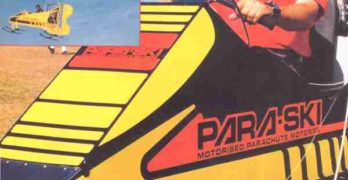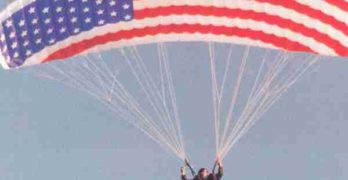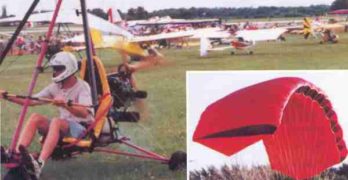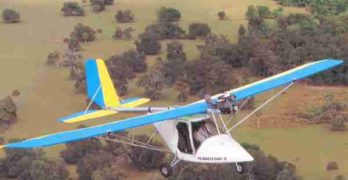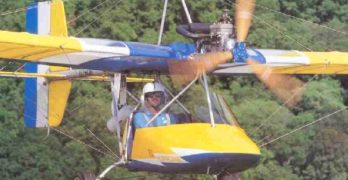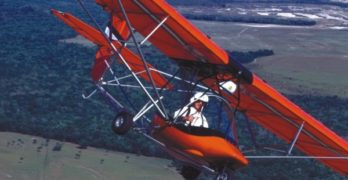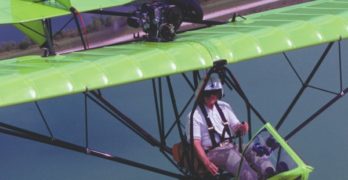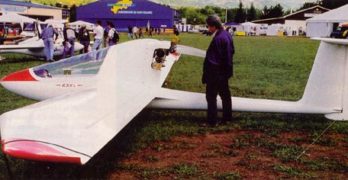You get four vehicles in one when you choose the powered parachute called Para-Ski. The name comes from the fact that you can swap wheels for skiis. With the correct selection this will permit zooming around – without a wing – on either water or snow, giving Para-Ski year ’round thrills.
What interests pilots, of course, is the ability to install a powered parachute and go aloft. But even in this airborne environment, Para-Ski offers more versatility. You can exchange the bag wing for a rag wing and, using some changed mount hardware, the Para-Ski become a trike ultralight as well.
Para-Ski is just full of differences, for example, its use of four wheels versus the more typical tri-gear favored by most other power parachute builders. Para-Ski feels this gives the machine more stability during takeoffs and landings and sure enough, when the canopy pulls to one side, I’ve seen company pilots keep the machine tracking straight on only two wheels (a tough maneuver with a three-wheeled model).
Search Results for : CT AND hand control
Not finding exactly what you expected? Try our advanced search option.
Select a manufacturer to go straight to all our content about that manufacturer.
Select an aircraft model to go straight to all our content about that model.
Daiichi Kosho — Whisper GTO
With the advent of the powered paraglider, trike ultralights lost their position as the smallest of powered aircraft. Once slope-launched gliding parachutes matured, power packages were added. Add a pilot’s seat to a backpack engine and the paraglider became a powered aircraft.
One of the most widely known brands to popularize this new concept is Daiichi Kosho Co., Ltd., of Japan. Their DK Whisper series is equipped with a harness for the pilot with built-in seat and a foot bar to yield a comfortable cockpit. The throttle is a hand operated unit with a new “cruise control” feature that lets the pilot fix a power setting for cruise or long duration climbs, which frees the hands for use of a GPS or camera.
The latest version of the Whisper blends the proven harness and frame that can reduce both engine torque reaction and gyroscopic precession. Daiichi says their new harness “is so agile that steering can be controlled by shifting body weight.” This weight shift capability adds to the standard method of hand toggles (which hang near your ear) whose purpose is to reshape the trailing edge of the parachute wing.
Buckeye Industries — Brat
Not many question Buckeye’s leadership role among producers of powered parachutes. They move a lot of flying hardware. Now to expand even further, Buckeye has offered the Brat, new in a couple interesting ways.
Buckeye’s little Brat is a single place aircraft. It can be fitted with one of the company’s canopy wings but that’s no longer all. Swap a couple tubes around and in a few minutes you can fix the trike carriage to a La Mouette Topless wing. This wing is one the top wings carrying hang glider pilots to record flights and contest championships. (Tested earlier with a Cosmos trike, I found the Topless wing offered superb trike handling.)
To keep the rig simple and provide for such switchability, the Brat employs hand toggles for canopy wing steering. Their standard powered parachutes use foot pedals to do this same controlling.
Flown for its first public introduction at Oshkosh 1997, the Brat appeared to be a particularly slow flyer with light touch handling – I never saw the pilot working hard to control the Brat.
Flightstar II
The popular Flightstar is solidly an American aircraft again after an excursion with overseas ownership. Original designer, Tom Peghiny, and his partner, Sparky LaMontagne, are majority owners in the Connecticut-based ultralight manufacturer. They’ve introduced four models to the community: Flightstar Classic (277 engine), Spyder (447-powered single place), Formula (deluxe full enclosure single seater) and Flightstar (top of the line two-place aircraft).
The Flightstar line distinguishes itself by featuring well engineered designs with cleanly executed hardware on a sleek, solid design. As they pass by in an airshow demonstration, viewers are pleased by the quiet performance of the machines. Factory pilots fly their two place model with the lighter 503 engine; it’s more than enough engine though you can add the more powerful 582. They go fast as well as slow and handle well at either end of the envelope. Present models offer flaps to further extend the speed range.
Efficiency is a watchword with the Flightstars.
Hurricane Company – Hurricane II
Fun people and fun planes probably always went together, but when you run into the Hurricane staff, you’ll better understand the combination. The Southern California manufacturer and crew apparently enjoy what they’re doing. They smile a lot and want to go fly their Hurricanes at the drop of a hat. All that pleasure shows up in an airplane that’s fun to buy, build, and fly.
Flying may be the best part. The Hurricane, deriving as it does from solid predecessors like the Phantom and Avenger, has refined the special form of ultralight flying to an art form. The Hurricanes typify ultralight aircraft to many folks, both pilots and first-airshow spectators. Open but protected from the wind by a high quality fairing and screen, the Hurricane preserves that wide-open feeling that gives the comfort of an enclosed cabin.
Though the handling is snappy enough for factory pilots to put the Hurricanes through some aerobatic paces, they also fly with well behaved manners.
Tenn. Engineering & Mfg – Max-103
TEAM, builder of the MiniMax, High Max, and other -Maxes, introduced their new Max-103 at Oshkosh 1993. With flowing lines, a snappy paint job and an adorable “convertible” canopy, the Max-103 was a hit with airshow goers.
TEAM president, Scott Severin, was the motivation behind changes to old serial #2 MiniMax, completely transforming it to the beautiful plane above. In order to keep the price low and building easy, the MiniMax has always shown rather boxy lines. The ‘103 was visually striking with fiberglass cowlings, a shapely turtle deck, and sweeping red and blue accent stripes over an clean white base.
Fortunately, TEAM didn’t mess with success, leaving the fine handling and solid feel intact. The MiniMax line is known for light controls with quick-not-jumpy aileron response. Taildragger takeoffs and landings are as easy as most tri-gear designs. A wide-open MiniMax is a joy to fly; the view is tremendous.
Not only is the Max-103 a hot little plane, it carries an absurdly low price tag.
Getting Up On A Breese
A M-Squared solidifies its position in the ultralight industry, the company rounds out its line of models with a pair of single-seaters to complement two 2-seaters already completed.
Welcome to fresh Mississippi Breeses.
M-Squared was born of a collaboration of 17-year Quicksilver veteran Paul Mather, and South Mississippi Light Aircraft (SMLA) owner Ronnie Smith. Mather started and solely owns M-Squared, but the two men have established a complementary working relationship.
Ronnie Smith and his wife built their SMLA operation into a regional powerhouse, selling Quicksilvers and other models through a chain of subdealers. Smith also established the southern enterprise as one of the few official American Rotax sales and service outlets and is also a supplier of many ultralight accessory items.
Mather conceived how Smith’s presence in the business might be combined with his own depth of experience and M-Squared rose as powerfully as the early 80-hp Rotax 912-equipped aircraft he debuted in the spring of 1997.
Golden Circle Air’s T-Bird I Is Easy On Pilots
Ten years ago, in the spring of ’93, I flew and reported on the nosewheel T-Bird I. Part 103 was barely 10 years old then and Sport Pilot/Light-Sport Aircraft concepts were a decade in the distant future.
This month we’re going to take a look at the taildragger T-Bird model. The good news through this passage of time is that the T-Bird I remains a delightful aircraft to fly. Anyone entering ultralight aviation should consider this plane among the fleet of possibilities.
Maybe you’re a bit overwhelmed by the steady stream of talk about FAA’s proposed Light-Sport Aircraft rule. The concept may be a bright light on the aviation horizon, but with another 6 months or more to wait, the patience of many pilots is wearing thin.
Even though I’m excited about this proposed new class of aircraft, I remain a true believer in the lighter, simpler, less expensive theory of ultralight aircraft.
Ultralight Motorgliders
The ultralight motorglider evolution continues in Europe.
Ultralight motorgliders are as rare as hen’s teeth in the U.S., but Europe is blessed with several choices that nicely complement high-end, high-priced full-size motorgliders. While America has the lovely Esprit from Aero Dovron, our soaring friends across the Atlantic continue to lead this specialized market.
Full-size (higher-weight) motorgliders start at more than $100,000 and can surpass $200,000. Those who can afford them are surely thrilled with such beautiful machines, but most of us can’t spend that kind of money regardless of their superb performance.
However, at $20-$30,000 ready-to-fly, a clean self-launching soaring aircraft is more affordable. Like their larger siblings, these efficient designs can also cruise under power respectably well, giving them broader appeal than pure gliders.
Noins’ Excel
One of the newest of the breed is the Excel from France’s Noins Aeronautiques Alpaero. Based in beautiful Tallard in the French Alps, Noins is revered by French soaring pilots.
Ultralight Rotorcraft? Here are Two
America is a great country, most pilots agree. We can fly our planes all over (except in TFRs) without special permission from the government. Pilots in many countries don’t have this privilege. We can fly all manner of aircraft, from factory-built, certified models to kitbuilt machines to ultralights.
We also have several regulatory programs under which we can fly our planes. You can use your pilot’s license under Part 61 and operate under Part 91. You will soon be able to get a sport pilot license that won’t require a medical and fly a light-sport aircraft with industry-devised certification (sanctioned and approved by the FAA).
Or you can operate under Part 103, the least-burdensome regulation in the flying world. All of Part 103 can easily be printed on two pages. Remarkable! After 21 years, the FAA’s simplest rule is still going strong. One proof is that designers keep introducing aircraft that fit FAR 103’s definitions.
- « Previous Page
- 1
- …
- 50
- 51
- 52
- 53
- 54
- …
- 61
- Next Page »


